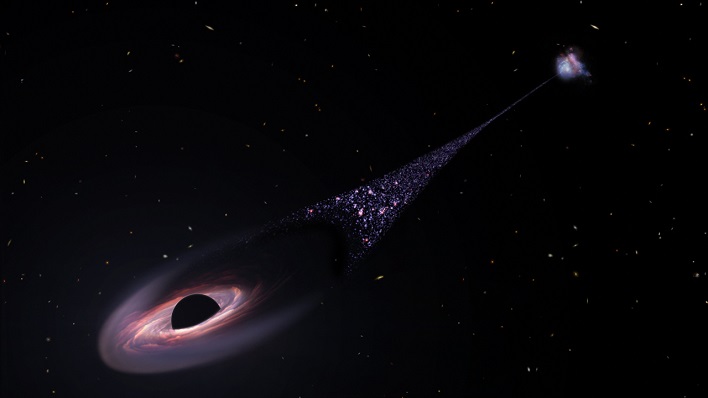Hubble Spots A Runaway Black Hole Lunging Through Space With A Huge Star Tail

The bridge first appeared to be a mere blemish captured by Hubble's electronic cameras, but spectroscopy proved it was a chain of young stars located halfway across the universe. The group of astronomers, led by Pieter van Dokkum, believe the black hole must be compressing gas along its vast path, which then condenses to form stars, according to a recent blog post on the Hubble Space Telescope's website.
"We think we're seeing a wake behind the black hole where the gas cools and is able to form stars. So, we're looking at star formation trailing the black hole," explained van Dokkum. "What we're seeing is the aftermath. Like the wake behind a ship, we're seeing the wake behind a black hole."
Nothing like it has ever been seen before and was accidentally captured by NASA's Hubble Space Telescope. The 200,000-light-year-long "contrail" of newborn stars, is said to be twice the diameter of our very own Milky Way galaxy. It is described as being the result "of a rare, bizarre game of galactic billiards among three massive black holes."

The team believes the bridge is likely the result of multiple collisions of supermassive black holes. Researchers believe the first two merged some 50 million years ago and then swirled around one another as a binary black hole. A third was introduced to the mix, leading to a chaotic and unstable configuration. Eventually, one of the trio was tossed to the wayside.
As the rejected black hole went off in one direction, the binary black holes "shot off" in the opposite direction. There is some evidence for this occurring, as the host galaxy has no sign of an active black hole remaining at its galactic core.
Astronomers have plans to do more follow-up research with the James Webb Space Telescope, Chandra X-ray Observatory, and the Nancy Grace Roman Space Telescope. A research paper was posted in the Astrophysical Journal Letters.

